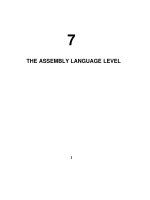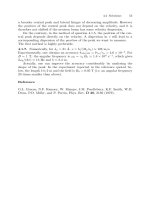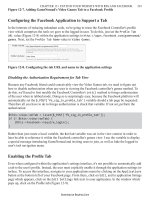The gmat writing skill 7 pdf
Bạn đang xem bản rút gọn của tài liệu. Xem và tải ngay bản đầy đủ của tài liệu tại đây (66.02 KB, 6 trang )
■
A good thesis makes an assertion about the topic; it does not just repeat the topic or ask a question.
Make sure your thesis takes a clear position on the issue or argument.
■
Your planning time is probably the most crucial part of an essay exam. Create a detailed outline to
organize your ideas. Revise your outline before you begin writing to make sure you have sufficient sup-
port and specific examples and that you have addressed all of the elements in the prompt.
■
Make sure you have at least two or three supporting ideas for your thesis. If no other organizational
pattern makes sense, put them in order of importance, with your most important idea last.
■
Remember, it’s important to get going and keep moving. If you can’t think of the exact word or phrase
you are looking for, approximate. You can come back to fix it later if you have time. For now, writing
something that is close enough must be good enough so you can get the rest of your ideas down.
■
Remember to keep it simple. Your time is limited, and your readers will be looking for basic structural
and organizational elements. Don’t worry about impressing your readers with sophisticated organiza-
tion or style; you don’t need anything out of the ordinary to impress your readers. A formulaic but
clear essay will do better than one that is overly complex.
■
Remember that first impressions are important, but it’s more important to finish your essay. Don’t get
hung up trying to write a perfect introduction. Simply summarize the argument or issue and state your
thesis. If you have time later, you can come back and write a catchier introduction.
■
Signpost, signpost, signpost. Use strong transitions throughout your essay to make the relationships
between ideas clear. Remember that both your human reader and E-rater® will be looking for these
guides.
■
A specific fact or detail has more power than a general statement. Include specific examples whenever
possible.
■
In general, unless you have less than five minutes left, revise first and then edit. Save your grammar and
spelling check until after you have made “big picture” changes to your essay. If you are nearly out of
time, read through your essay quickly and make any revisions or editorial changes.
■
If a sentence seems unclear to you, it may be that you are trying to do too much in one sentence. Try
breaking it up into two simpler sentences that are more clear.
■
Remember the guidelines for effective style: be precise, be concise, use the active voice, vary the sen-
tence structure, and avoid jargon and pretentious language. Make sure you use an appropriate level of
formality and a serious, respectful tone throughout your essay.
■
Correct punctuation is important, but don’t get hung up on trying to determine whether you need a
comma or a semicolon. Make your choice quickly and move on to the next issue.
■
If you are unsure about capitalization, ask yourself whether the word in question is something specific
or general. If it is a specific person, place, or thing, then it probably should be capitalized. Remember, in
this regard, specific means particular or individual, not detailed. For example, a poodle is a specific type
of dog, but it is not capitalized because it doesn’t refer to a specific (individual or particular) dog.
Rover, however, should be capitalized because Rover is a specific (individual or particular) dog.
■
If you have the time, read your essay backward line by line. This will enable you to spot errors that you
might miss reading straight through.
– TIPS AND STRATEGIES FOR THE AWA–
268
Analyzing the Issue
■
Remember that in the Analysis of an Issue essay, there is no correct answer. A good essay will take a
clear position and support that position. Don’t be afraid to say what you think. Just be sure to back up
your opinion.
■
A strong issue essay will address counterarguments. Take a minute to imagine how someone taking the
opposite point of view would support that position. Acknowledge key concerns and then show why
your position has more merit.
Analyzing the Argument
The argument you are presented with on the GMAT exam may have many different problems. To address all
of the different possibilities, break down your analysis into two steps: (1) what the argument has and (2) what
it might be missing:
1. What is already there? Check the premises and conclusion. Are the premises (stated and unstated)
logical? Do they lead logically to the conclusion? Is the evidence strong and convincing? Are there any
fallacies in the argument?
2. What might be missing? What alternative explanations or counterarguments are missing from the
argument? What evidence would strengthen the conclusion? What missing information would help
you better evaluate the argument?
– TIPS AND STRATEGIES FOR THE AWA–
269
the Analysis of an Argument section. Use these prompts to practice your timed writing skills for the AWA.
Give yourself 30 minutes for each essay. Sample essay responses are provided after the sample prompts.
To create a realistic testing scenario, it is important that you do not read the prompts until you are ready
to begin your timed session. Even a quick glance at the topic will give you the opportunity to start develop-
ing ideas for an essay. Remember, you will not have any incubation period on the GMAT® exam; you will only
receive your topic when your timed writing session begins.
You will have to write two essays in a row on the GMAT exam, so practice doing one of each kind of
essay consecutively. The first few times you may find that you lose steam on the second essay; after all, writ-
ing two essays in just one hour is hard work. But the more you practice, the easier it will become, and the more
comfortable you will be with pacing yourself through the writing process.
It is also critical that you use a computer with a basic word processor to practice writing the essays.You
will not have the option of writing the essays by hand on the AWA, so you must be comfortable composing
and revising on the computer. Be sure to turn off the spell check and grammar check; the word-processing
program on the GMAT exam will not include either of these features. Have several sheets of scratch paper
available so that you can brainstorm and outline your essays.
CHAPTER
AWA
Practice
17
271
Analysis of an Issue Sample Prompts
1. A leader who is respected is more powerful than one who is feared.
Discuss the extent to which you agree or disagree with this opinion. Support your position with
reasons and/or examples from your own experience, observations, or reading. Complete your essay in
30 minutes.
– AWA PRACTICE–
272
2. The main goal of education should be to teach students to be good citizens, not to prepare them for the
workplace.
Discuss the extent to which you agree or disagree with this opinion. Support your position with
reasons and/or examples from your own experience, observations, or reading. Complete your essay in
30 minutes.
– AWA PRACTICE–
273









